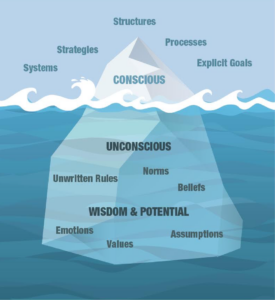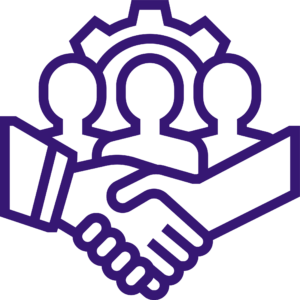If culture could be represented as the fabric of an organization, then diversity, equity and inclusion is an essential thread that helps create that fabric. Many organizations are grappling with how to create an inclusive and equitable environment in order to retain employees and engage them to do their best work. That effort cannot succeed unless the organization’s culture reflects and supports it.
“Culture” Defined
An iceberg analogy¹ is a great way to describe organizational culture — it’s hard to see, measure and define, but determines how employees navigate.
Specifically, culture is a set of assumptions that guide how members of an organization think and behave. It occurs at three levels:
● What We See: Visible behaviors, structures and processes
● What We Say: Values, strategies, goals and philosophies
● What We Assume: Unconscious beliefs, perceptions, thoughts and feelings

How DEI Connects to Culture
Diversity, equity and inclusion run through each level that defines culture. If you only focus on one level, your efforts will fall short of actively shaping the culture. For example, let’s assume your DEI efforts are to increase representation and you choose to target your recruiting function to meet this goal. If your strategy is to create a recruiting quota, you may have an impact on shaping the culture in terms of what employees see. However, without a more tailored and strategic focus, you will not change the culture around what employees say or assume.
Culture can be shaped, evolved or influenced, but not changed directly. In this example of a recruiting quota, it’s a tactical and solitary effort, so you can expect that there will be minimal impact on the culture or your DEI goals. In order to influence change, your goal should be to uncover issues and challenges that are hindering the culture. Discovery methods such as surveys and focus groups can help you explore to discover what’s in your way.
What Meaningfully Contributes to an Inclusive Culture?
Organizations are dynamic human systems that constantly evolve. Systemic changes play the biggest influence in that evolution. Talmetrix fielded a Diversity & Inclusion Climate survey to assess the current inclusion experience in organizations. Our intent was to uncover which systemic items have the biggest impact on the employee experience by analyzing the data via different diversity dimensions and demographics..
Through research of diversity and inclusion topics and constructs, Talmextrix developed a list of factors that were considered notable to maintaining an inclusive culture. These included:
1. Fair and Inclusive Treatment:
Support from managers, feeling of inclusion
2. Connectedness:
Being your authentic self at work
3. Discrimination and Harassment:
Overt and covert discriminatory and harassment behaviors
4. Beliefs and Attitudes:
Value of diversity and inclusion at work and its place at work; understanding how it’s perceived and valued; employee mindset is helpful when thinking about inclusion climate
5. Leadership Commitment:
Proactive support and accountability for managing diversity and inclusion drives top-down across the organization
The survey sought to uncover how the above five notable factors impacts these two outcomes:
Employee Commitment
An employee’s sense of emotional attachment and willingness to recommend the organization
Employee’s Intent to Stay
An employee’s thought of leaving and action of staying
Diversity & Inclusion Climate Survey Findings
The survey gathered feedback from 880 respondents from across work industries and representing diversity in race, gender and ethnicity. The findings revealed key discoveries about what an organization can do to ensure the culture can attract diverse talent, engage, retain and create an inclusive and equitable environment were related to driving employee commitment:
Employee Commitment
The top driver was Connectedness, or the perception of being accepted as your authentic self at work
Employee’s Intent to Stay
The top driver was the frequency in experience of Discrimination and Harassment, where the higher the prevalence of such behaviors, the lower the intent to stay
Five Tips for Leaders
In our What Make a Diverse & Inclusive Culture webinar, Bernard Guinyard, Transformational Diversity & Inclusion leader shared some organization-changing, actionable strategies for leaders. By taking these actions, leaders can more effectively embed DEI into their organization.
Here are five of those tips:
1. Go Beyond Training
Diversity, equity and inclusion efforts often start and end with training. It’s important, but not a solution. Commit to taking more action than offering/attending the diversity workshop series.
2. Create Public Accountability
Every relationship thrives on feedback. It’s also what can take DEI goals from a lofty dream to a reality. Develop mechanisms that make everyone – leaders, managers and employees – accountable for DEI goals. Break your diversity and inclusion strategy down to the department level and share those expectations. People need to feel that the organization is moving forward and not just talking about it.
3. Use a Data-Oriented Approach
Employee engagement itself leads to a more inclusive culture. Gathering engagement data, studying it for meaning and then implementing actions based on what you learned can get you on the right track to implementing programs that will impact your culture, including D&I aspects.
BONUS TIP:
Kelsie Pytlik, co-founder of Gild Collective also shared this powerhouse tip related to data:
Data doesn’t always show a shared experience. Follow-through on the data to confirm that it’s actionable and resonates across groups. Don’t assume that a trend you notice for women is shared across women. Go deeper.
4. Triage Actions Based on Employee Life Cycle
Align your data with the employee experience. How? Consider each inflection point of the employee life cycle – recruiting, performance management, promotion, exiting, etc.). Determine the gaps and action plan based on that information. For example, does your engagement for Latino employees lag two years after they join the organization? If so, a strategy for new hires wouldn’t solve that.
5. Collect the Lived Experiences, Too
We’re clearly fans of data, yet data is lagging and very often, not real-time. Most surveys are collected periodically – and sometimes only once a year. So it’s important to also gather lived experiences. That is, how does the current workforce feel? Do they feel connected, valued, treated fairly? Build in opportunities for employees to speak up so you’ll be in tune with current trends.
Watch Our Webinar on What Makes A Diverse & Inclusive Culture
Learn more! We shared more details on survey findings and spoke with industry leaders to get tips on how to get this right. Check out our webinar available now on our website.
https://f.hubspotusercontent00.net/hubfs/345155/WhatMakesaCultureDiverseandInclusive.mp4
Need support with your DEI initiatives? Contact Us.
¹ Iceberg analogy is attributed to Ed Schein at http://www.scheinocli.org/.


